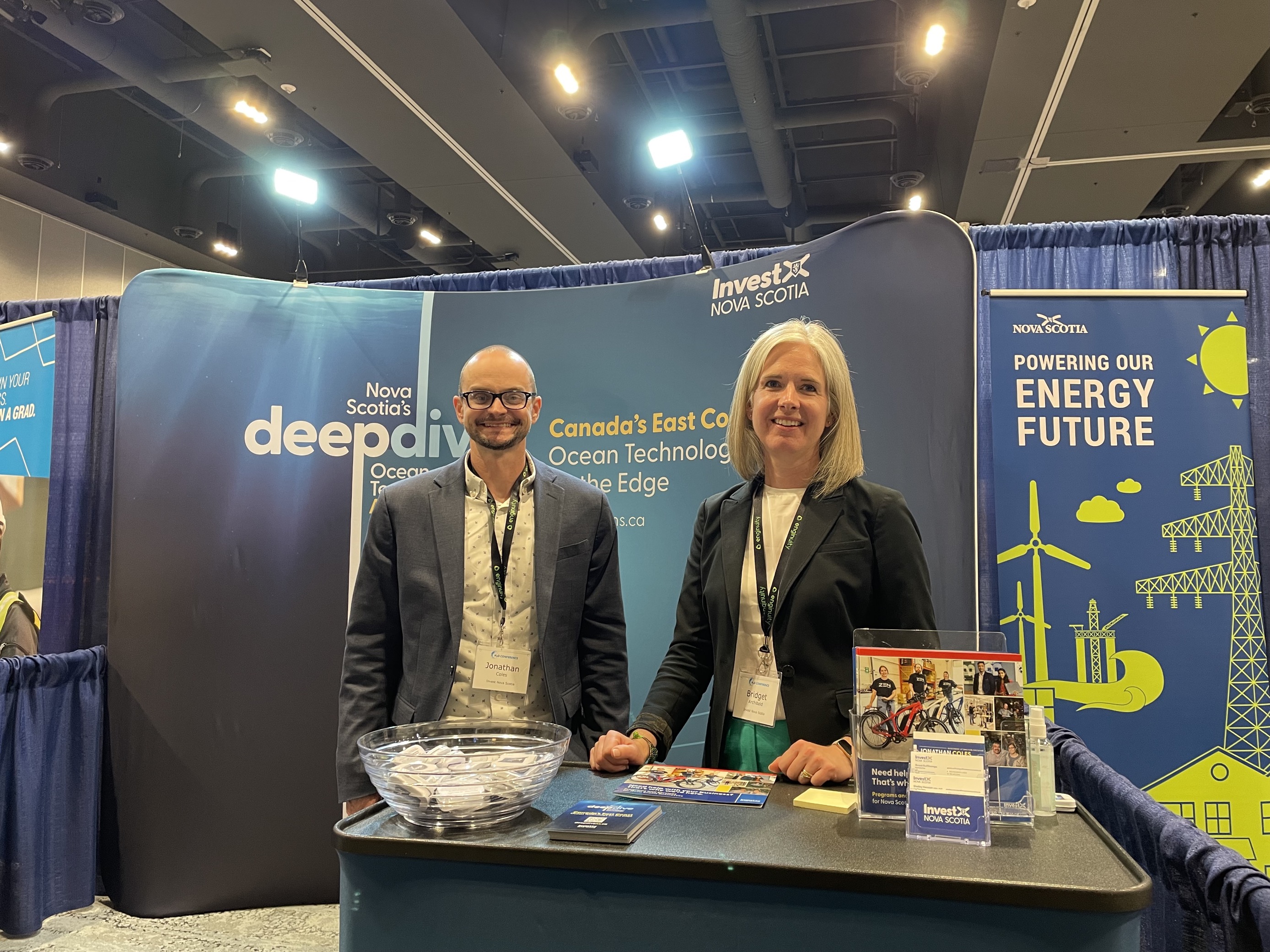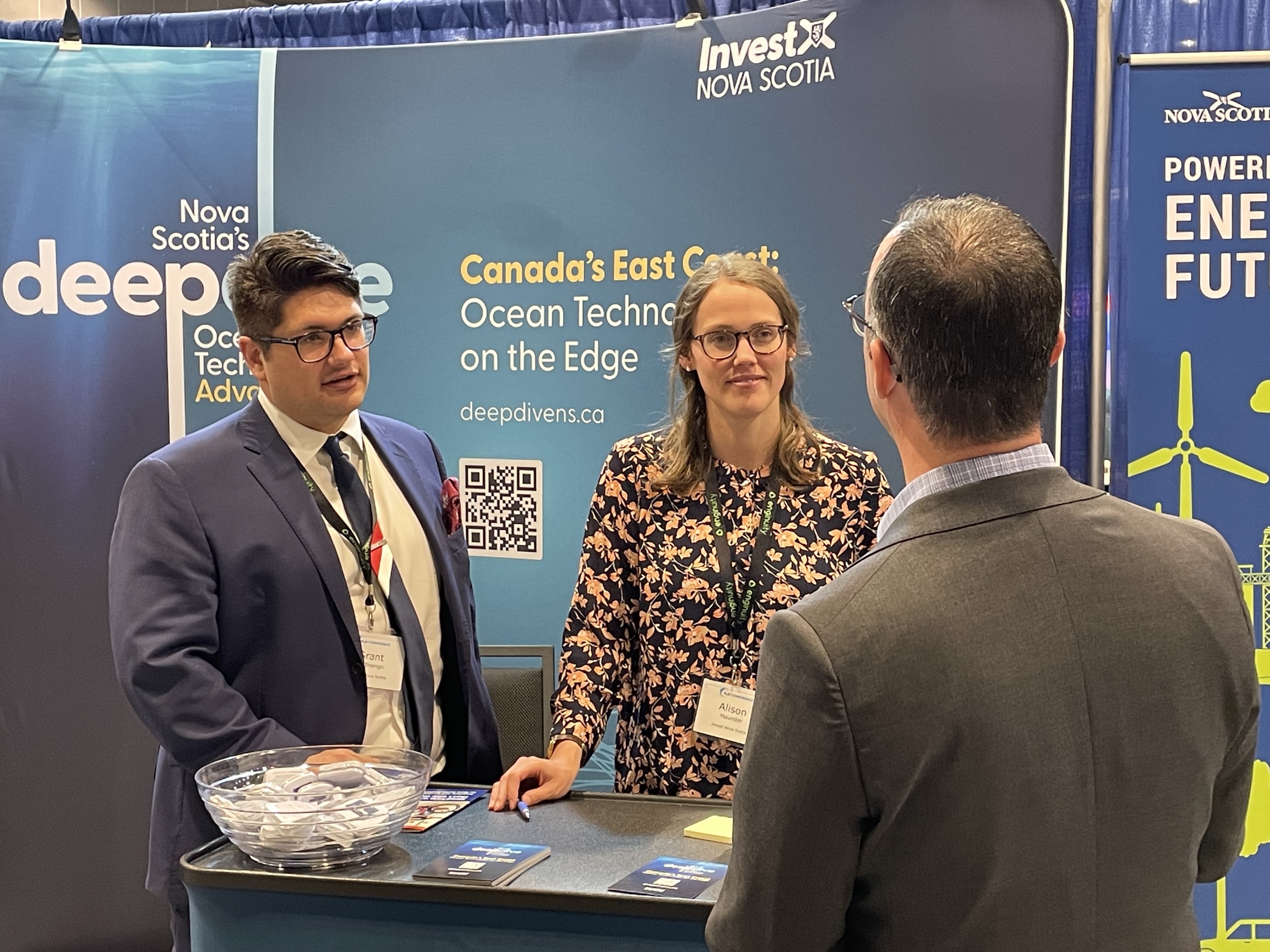On the ground at H2O with Invest Nova Scotia
Tuesday, July 4, 2023
Atlantic Canada, and Nova Scotia in particular, are home to a strong cluster of ocean industries and ground-breaking research and are quickly becoming a globally recognised hub of oceans expertise.
Now in its eighth year, the H2O Conference 2023 is an ideal event to engage with the ocean technology industry.
We caught up with some Invest Nova Scotia colleagues at this year’s H2O Conference to discuss their observations and experiences, as well as innovations on the horizon in the world of ocean technology.
Bridget Archibald
Export Development Executive, Invest Nova Scotia
“Other forms of renewable energy, like harvesting wave energy to help power things on the ocean, are also of growing interest. Anything that helps with decarbonization. Offshore wind installations are an opportunity for ocean technology companies that are engaged with activities like surveying the seabed, monitoring for marine mammals and other sea-life, maintaining wind farms – the list goes on. Many Nova Scotia-based companies are already gaining experience in this industry, exporting their services, scaling up, working in other countries. They have expertise and will be ready to support this industry at home as well.”
“Technologies that help identify or protect biodiversity or help with climate change are key. This could be things like eDNA sampling, rope-less fishing gear, or measurement/mitigation of the ocean as a carbon sink.”
Bridget also mentions electric and autonomous vessels are growing fields of interest. “My understanding is, when you think about ferries, fishing vessels, coast guard, navy, container ships – it is likely the smaller vessels with short trips that will be electric in the future and the larger vessels with longer durations that may go another route, such as using hydrogen or liquified natural gas. But then there are all sorts of technologies being layered to reduce fuel consumption. Some of them are physical changes to the vessels, like slippery hull coatings, or new propeller designs, and others involve AI and optimal ship routing. These are all opportunities ocean technology companies are bringing to the table.”
“We saw autonomous vessels during COVE Demo Day, where a route is pre-programmed, and no crew is needed. We are in the early days of this industry, but we’re already seeing small vessels with autonomous capability and AI working behind the scenes. Same for marine robotics. This is something regulators around the world are catching up on.”
This leads into another of Bridget’s observations from H2O, which is a growing focus on the human side, particularly around safety and diversity.
“Having remotely operated vehicles doing tasks like survey work means people don’t need to be on larger vessels that were previously used to do the same tasks. Safety is highlighted in terms of electric vessels making less noise, which means less risk of hearing loss for crew, making it easier to communicate and less fatigue.”
“Diversity in the sector is a big focus. The industry and the ecosystem are working to attract more women, more people from underrepresented groups and more indigenous participation. At this year’s conference, there was also a quiet “Welcoming Space” offered by Ocean Allies as a place people could go for a break from the busy conference. They recognize some people really need that. At the same time, there were literally hundreds of meetings taking place at the conference, as it had also a dedicated meetings venue and platform. It’s quite exciting to think of all the new business and connections that took hold during H2O.”
Alison Maunder
senior Sector Strategist, Invest Nova Scotia
“There was a great session highlighting the programs and work that’s happening in the province around diversity, equity, inclusion, and accessibility (DEI&A) and what resources are available to companies. Ocean Allies, an organization focused on increasing diversity in the ocean sector, launched the Ocean Impact Award, which recognizes and celebrates ocean businesses that exemplify DEI&A in Canada.”
“Another interesting theme was around helping to create and grow more ocean start-up companies. Companies taking part in the Ocean Start-Up Project discussed the challenges and opportunities for other companies in the blue economy and was a great way to demonstrate the young talent we have in the region.”
Alison noticed much more of a focus on venture capital (VC) activity this year than in the past. “Attracting private VC is still a major challenge in the blue economy because product development takes a long time and a lot of the R&D is in ‘deep technology,’ which limits investors’ ability to do due diligence and is often outside of their expertise. A lot of ocean technology start-ups come out of universities and need to be matched with business expertise to scale. One panelist commented that VC/private investment in the blue economy is where clean technology was 10 years ago and will grow as more companies prove the investment is worth it. There needs to be more big exits to pull investors into the sector.”
“The panelists recommended companies try to identify applications for their products outside the ocean sector to draw in investors from larger, more mature industries, such as consumer products. Additionally, large multi-national companies that partner with and invest in start-ups are powerful drivers of commercialization and innovation since they provide start-ups with an immediate customer.”
Lastly, Alison highlighted the Ocean Supercluster and their new strategic plan and ambitions for the Canadian ocean economy by 2035.
“The Ocean Supercluster identified four themes for investment, which all align nicely with Nova Scotia’s strengths: Scaled Ocean Energy, Sustainable Seafood, Future Ocean Transportation & Ocean Climate Solutions. The common goal is for our ocean economy to grow by 5x and be worth $220 billion which creates enormous potential for Canada and for companies operating in the blue economy.”
Learn more about doing business in the ocean technology in Nova Scotia: https://investnovascotia.ca/business/oceantech.






